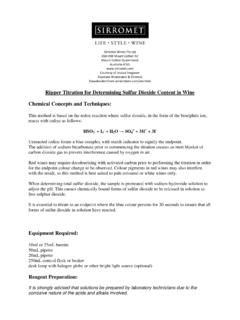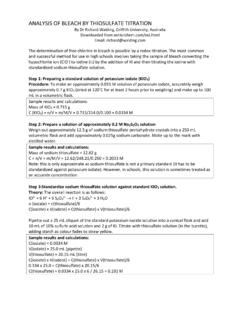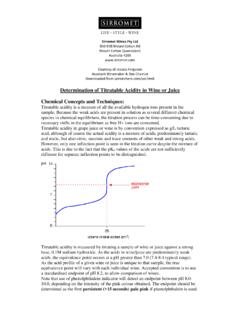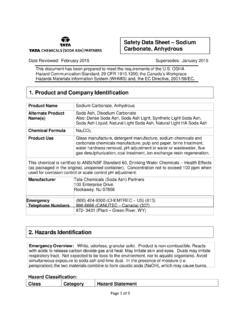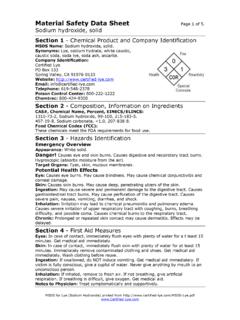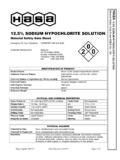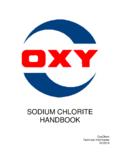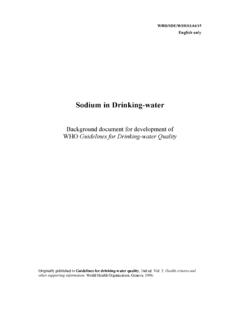Transcription of Effect of relative humidity and temperature on moisture ...
1 International Journal of Pharmaceutics 166 (1998) 167 175 Effect of relative humidity and temperature on moisturesorption and stability of sodium bicarbonate powderWei-Youh Kuua,*, Rao Chilamkurtia, Chi ChenbaPharmaceutical Sciences R& Di6ision,Baxter Healthcare,Round Lake,IL60073,USAbRenal Di6ision,Baxter Healthcare,McGaw Park,IL60085,USAR eceived 7 April 1997; received in revised form 19 November 1997; accepted 9 January 1998 AbstractThe effects of relative humidity and temperature on moisture sorption rate and stability profile of sodiumbicarbonate powder exposed to various storage conditions were investigated using gravimetrical and acid-titrationmethods. In the study, samples were placed in desiccators, which contained various saturated salt solutions togenerate desired levels of relative humidity , denoted as RH, ranging from 30 93% RH.
2 The weight of each samplewas determined periodically. The results show that both the temperature and relative humidity are key factors inmoisture sorption isotherm and decomposition kinetics. The threshold relative humidity RHthis defined as the relativehumidity above which sodium bicarbonate powder starts to rapidly gain weight. The critical relative humidity RHcis defined as the relative humidity above which sodium bicarbonate powder either starts to rapidly gain weight orstarts to rapidly hydrolyze (resulting in losing weight). The moisture sorption isotherm shows an unusual phe-nomenon at high RH, where the weight of the sodium bicarbonate powder either increases or decreases with time,depending on the storage temperature .
3 When the powder is exposed to a lower temperature and high humidity level( at 25 C and 93% RH), the weight increases rapidly, due to the fact that the relative humidity exceeds the RHthat this temperature . On the other hand, when the powder is exposed to higher temperature and high humidity levels( at 40 C, 89% RH and at 55oC, 82% RH), the weight of the powder decreases with time since the relativehumidity is below the RHthat these temperature levels and the decomposition rate is higher than the moisturesorption rate. The decomposition of sodium bicarbonate results in the release of carbon dioxide. The values of RHcat 25 and 40 C were determined to be between 76 and 88% RH and between 48 and 75% RH, respectively.
4 Theaccurate moisture content and the stability profiles of sodium bicarbonate were determined using a titration-drying-ti-tration procedure. The results of determination show that sodium bicarbonate powder is stable below 76% RH at25 C and below 48% RH at 40 C, respectively. 1998 Elsevier Science All rights :Critical relative humidity ; moisture sorption; sodium bicarbonate; Equilibrium moisture content; Decom-position kinetics; Hydrolysis; Titration drying titration* Corresponding :98:$ 1998 Elsevier Science All rights (98) et al.:International Journal of Pharmaceutics166 (1998) 167 1751681. IntroductionSodium bicarbonate is an important componentin various pharmaceutical solid and liquid dosageforms.
5 Because of its widespread use, the stabilityof sodium bicarbonate in solid state, both as araw material and as a formulation component, isof high interest to the pharmaceutical sodium bicarbonate is stored as a powder,it degrades over time to carbon dioxide andsodium carbonate after sorption of moisture atlower temperature , or degrades directly to carbondioxide and sodium carbonate without sorption ofmoisture at elevated temperature (Shefter et al.,1975). Therefore, it is critical to maintain appro-priate temperature and relative humidity duringthe storage of the raw material and finishedproduct as well as during studies regarding the thermal decompo-sition of sodium bicarbonate under various condi-tions have been reported.
6 Krupkowski (1938)investigated the decomposition of sodium bicar-bonate powder in an open system, by means of aheating curve and reported a temperature decom-position of 124 C. Shefter et al. (1975) reportedthe kinetics of solid state transformation ofsodium bicarbonate to sodium carbonate in anopen system at 82 95 C. Studies conducted byUsui and Cartensen (1985) included sodium bicar-bonate stability at 70 C in open and closed sys-tems. Ahlneck and Alderborn (1989) investigatedmoisture sorption of sodium bicarbonate at 25 Cand relative humidity ranging from 33 100% butdid not study the stability of sodium bicarbonateat these rate of sodium bicarbonate decompositionto sodium carbonate is dictated by the moisturesorption kinetics at given temperature and humid-ity conditions.
7 The release of carbon dioxide re-sults in a decrease of powder mass and therefore,the moisture sorption isotherm of sodium bicar-bonate is unique compared with other pharma-ceuticals. For example, at room temperature andhigh humidity , a rapid increase in powder masswould be expected because of significant moisturegain and relatively low rate of carbon dioxideformation; however, at elevated temperature , adecrease in powder mass would be expected dueto rapid formation and release of carbon dioxidewith relatively low rate of moisture sorption. Areview of literature shows lack of information onmoisture sorption and related stability of sodiumbicarbonate at controlled temperature and humid-ity conditions.
8 Therefore, the purpose of thisstudy was to investigate the moisture sorption ofsodium bicarbonate and associated stability atvarious temperature and humidity conditions andto determine the critical humidity at given valuesof storage Materials and designFor convenience of discussion, the thresholdrelative humidity RHthis defined as the relativehumidity above which sodium bicarbonate pow-der starts to rapidly gain weight. The criticalrelative humidity RHcis defined as the relativehumidity above which sodium bicarbonate pow-der either starts to rapidly gain weight or starts torapidly hydrolyze (resulting in losing weight).With these definitions, the value of RHcis alwayslower than or equal to RHth.
9 A stagewise ap-proach was undertaken to determine the criticalrelative humidity of sodium bicarbonate at 25, 40and 55 C. In stage 1 study, the approximate rangeof RHcwas determined using the three saturatedsalt solutions, MgCl2, Mg(NO3)2and KNO3,which corresponds to the three levels of relativehumidity at 25 C, 33, 52 and 93% RH, respec-tively. In stage 2 study, the range of the RHcwasfurther refined using the additional two saturatedsalt solutions NaCl and Li2SO4, which generatedthe two levels of relative humidity at 25 C, 76 and88% RH, sorptionThe five saturated salt solutions, MgCl2,Mg(NO3)2,NaCl, Li2SO4, and KNO3, were cho-sen to control various levels of relative the relative humidity of these solutionssomewhat varies with temperature , the actual rel-ative humidity levels for these solutions et al.
10 :International Journal of Pharmaceutics166 (1998) 167 175169from the literature (Greenspan, 1977; Callahan etal., 1982; Umprayn and Mendes, 1987) are listedbelow: (33, 52, 76, 88 and 93% RH) at 25 C, (32,48, 75, 88 and 89%) at 40 C, and (30, 44, 74, 88,and 82%) at 55 C. It is noted that the threerelative humidity values at 55 C, 44, 88, and 82%,were estimated in this work from the above litera-ture data at 15 50 C using regression equations,since the experimental data at this temperatureare not available. A thin layer ( g) of sodiumbicarbonatepowder(Mallinckrodtanal yticalreagent, Lotc7412 KMPT) was spread in eachglass drying dish ( cm in inside diameter cm in height) using a brush. The dishes wereplaced in the desiccator which contained a satu-rated salt solution that generated a desired rela-tive humidity .
